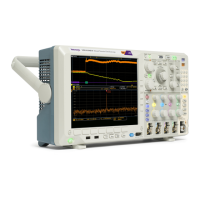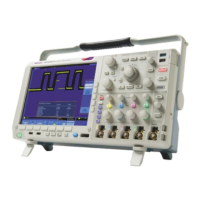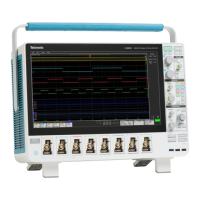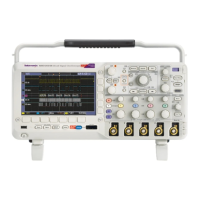



Do you have a question about the Tektronix MSO4034 and is the answer not in the manual?
| Bandwidth | 350 MHz |
|---|---|
| Analog Channels | 4 |
| Digital Channels | 16 |
| Sample Rate (Analog) | 2.5 GS/s |
| Record Length | 10 Mpoints |
| Input Impedance | 1 MΩ ±1%, 13 pF ±2 pF |
| Vertical Sensitivity | 1 mV/div to 10 V/div |
| Vertical Resolution | 8 bits |
| Power Supply | 100-240 VAC, 50/60 Hz |
| Display | 10.4-inch color TFT LCD |
| Trigger Types | Edge, Pulse Width, Logic, Video, Rise/Fall Time |
| Interface | USB, LAN, GPIB |
| Maximum Input Voltage | 300 V (DC + peak AC) |
Safety precautions for preventing fire and personal injury during product operation.
Details on Electromagnetic Compatibility standards and EC Declaration of Conformity.
Information on safety standards, UL listing, and Canadian certification.
Step-by-step instructions for safely connecting and powering on the oscilloscope.
Procedure for properly shutting down and disconnecting the oscilloscope from power.
Guide on how to properly compensate passive voltage probes for accurate measurements.
Overview of the front panel buttons, knobs, and menu system for operating the oscilloscope.
Procedures for connecting and configuring analog channels to capture input signals.
How to adjust acquisition parameters like mode, record length, and delay for optimal signal capture.
Guide to configuring triggers and decoding various serial and parallel bus protocols.
Steps for setting up and acquiring signals using the digital channels of the oscilloscope.
Explanation of Normal and Auto trigger modes and their behavior in the absence of trigger events.
Controls for determining trigger point on signal edges and specific voltage levels.
Guide on how to select from various trigger types like Edge, Sequence, Pulse Width, etc.
Detailed explanations of different trigger types and their specific conditions for signal capture.
How to set up triggers for various serial and parallel bus protocols using application modules.
Combining Main and Delayed triggers to capture more complex signal sequences.
Procedures for initiating and halting waveform acquisitions using Run/Stop or Single buttons.
Adjusting waveform vertical position and scale, and setting input parameters for accurate display.
Configuring input parameters like coupling, impedance, bandwidth, and probe settings for channels.
Procedures for taking automatic measurements of signal parameters like frequency and amplitude.
Using on-screen cursors for manual measurements of acquired waveform data.
Breaking down signals into component frequencies using FFT for frequency domain analysis.
Utilizing Wave Inspector controls for efficient work with long record length waveforms.
How to use the Autoset function to quickly display and optimize a signal on the oscilloscope.
Setting up the oscilloscope to trigger on NTSC, SECAM, and PAL video signals for stable display.
Setting up for single-shot acquisition to capture transient events like relay contact opening.
Monitoring and analyzing parallel bus signals using digital channels and search/mark functions.
Analyzing RS-232 bus signals for signal integrity and decoding data into ASCII characters.











